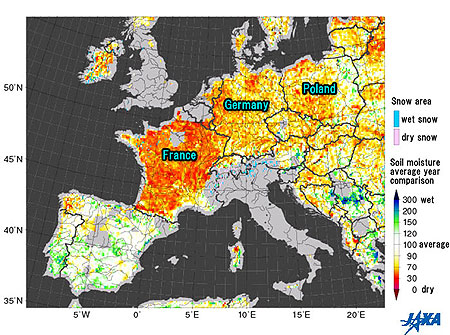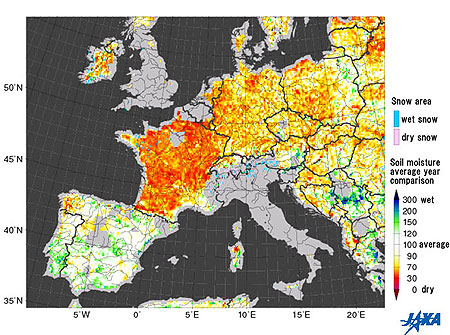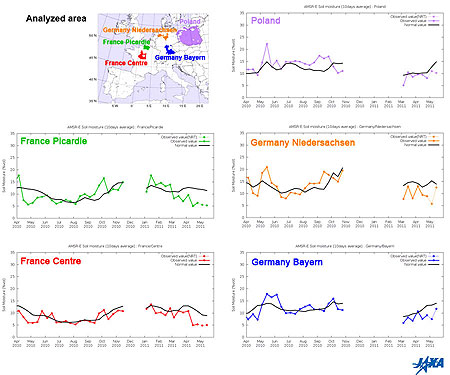

Latest Observation
2011.06.22 Wed
The European Continent Is Drying Up
caption on
caption off
The Advanced Microwave Scanning Radiometer for EOS (AMSR-E*) was developed by the Japan Aerospace Exploration Agency (JAXA) and is on board NASA’s Earth-observing satellite, Aqua. Figure 1 shows a comparison of soil moisture in Europe between the average year and May 1 to May 20 this year. The colors in Fig. 1 indicate the degree of dryness of the soil. White indicates dryness as the average; then yellow to red show soil of greater degrees of dryness. In the European continent, France, Germany, and Poland are becoming drier. The soil moisture in France, especially, is below average compared to average year levels. This figure was provided to the Ministry of Agriculture, Forestry and Fisheries of Japan and reported in the “Overseas Food Demand and Supply Report in May 2011.”
The gray areas show areas where it is difficult to analyze the data. The snow areas are located in Italy.
*AMSR-E is an Advanced Microwave Radiometer developed by the Japan Aerospace Exploration Agency (JAXA) and is on board Aqua, a satellite in NASA’s Earth Observing System. It was launched in 2002 and has since been collecting data of ocean surface temperature, precipitation, soil moisture, and sea ice caps in the Arctic Ocean.
Figure 2 shows changes in soil moisture in some areas of Europe from April 2010 to May 2011. The black lines show average year soil moisture. It is noted that each area shows low levels of soil moisture from the spring of 2011. Especially, two areas in France show severe dryness. The lines break off around December 2010. This is due to data missing because of snow coverage.
Europe produces around 140 million tons of wheat, which accounts for around 20 percent of global wheat production. European barley occupies 40 percent of the global crop production at 54 million tons. And one-third of rapeseed produced globally is grown in Europe. There has been little precipitation since the beginning of the year around the United Kingdom, France, and Germany. The northern part of France has seen the lowest amount of precipitation in the last 50 years. Fears have been voiced that this dry spring season will cause a drop in agricultural production.
G20 Agricultural Ministers Meeting To Be Held
The first Agricultural Ministers meeting of the G20 (twenty countries and areas including the USA, the EU, and Japan) will be held in Paris, France. Shortages in production have caused the price of food to soar. The cause of the shortages, as observed by the satellite data, has been the abnormal climate. The main themes of the meeting will be food security and price stabilization. Satellite observation data is expected to be used in the area of food security.
Explanation of the Images:

| Satellite: | Earth Observing System, Aqua, NASA |
| Sensor: | Advanced Microwave Scanning Radiometer for EOS (AMSR-E) |
| Date: | May 1, 2011 to May 20, 2011 (Fig. 1) April 1, 2010 to May 20, 2011 (Fig. 2) |
Search by Year
Search by Categories
Tags
-
#Earthquake
-
#Land
-
#Satellite Data
-
#Aerosol
-
#Public Health
-
#GCOM-C
-
#Sea
-
#Atmosphere
-
#Ice
-
#Today's Earth
-
#Flood
-
#Water Cycle
-
#AW3D
-
#G-Portal
-
#EarthCARE
-
#Volcano
-
#Agriculture
-
#Himawari
-
#GHG
-
#GPM
-
#GOSAT
-
#Simulation
-
#GCOM-W
-
#Drought
-
#Fire
-
#Forest
-
#Cooperation
-
#Precipitation
-
#Typhoon
-
#DPR
-
#NEXRA
-
#ALOS
-
#GSMaP
-
#Climate Change
-
#Carbon Cycle
-
#API
-
#Humanities Sociology
-
#AMSR
-
#Land Use Land Cover
-
#Environmental issues
-
#Quick Report
Related Resources
Related Tags
Latest Observation Related Articles
-
 Latest Observation 2025.10.01 Wed [Quick Report] Hurricane Humberto “Eye” captured by EarthCARE satellite (Hakuryu)
Latest Observation 2025.10.01 Wed [Quick Report] Hurricane Humberto “Eye” captured by EarthCARE satellite (Hakuryu) -
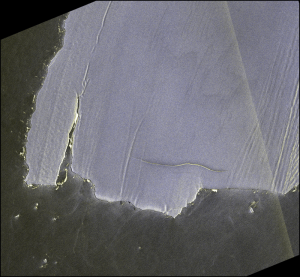 Latest Observation 2025.02.28 Fri The world’s largest iceberg, A23a, may have run aground on the continental shelf of South Georgia:
Latest Observation 2025.02.28 Fri The world’s largest iceberg, A23a, may have run aground on the continental shelf of South Georgia:
The trajectory of iceberg A23a observed by “GCOM-W”, “ALOS-2” and “ALOS-4” -
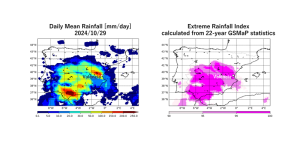 Latest Observation 2024.11.06 Wed [Quick Report] Heavy rainfalls in eastern Spain, as seen by the Global Satellite Mapping of Precipitation (GSMaP)
Latest Observation 2024.11.06 Wed [Quick Report] Heavy rainfalls in eastern Spain, as seen by the Global Satellite Mapping of Precipitation (GSMaP) -
 Latest Observation 2024.10.11 Fri Antarctic Winter Sea Ice Extent Second lowest in Satellite History
Latest Observation 2024.10.11 Fri Antarctic Winter Sea Ice Extent Second lowest in Satellite History










